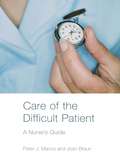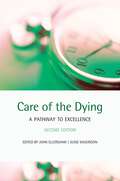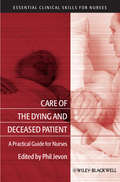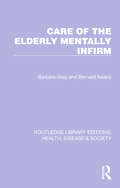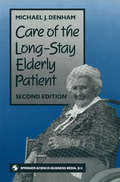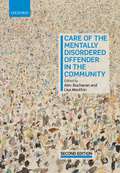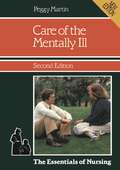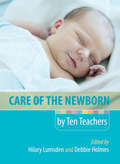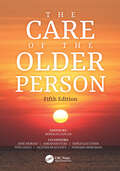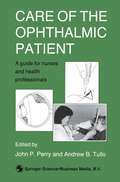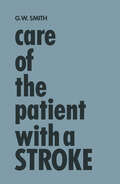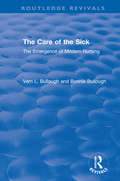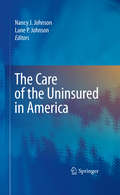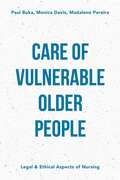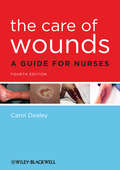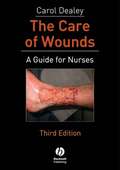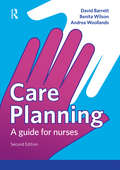- Table View
- List View
Care of the Difficult Patient: A Nurse's Guide
by Peter Manos Joan BraunDeveloped collaboratively by a doctor and nurse team, this is the first text to deal specifically with nursing difficult patients. Whether patient problems stem from mental distress and ill health, historic substance abuse, demanding family members or abusive behaviour, difficult patients place extra demands on nurses both professionally and personally. Caring for difficult patients requires both technical and interpersonal skills along with an ability to exercise power and set limits. This text presents invaluable practical recommendations and advice, well founded in experience and supported by relevant literature, for nurses coping with challenging, real world situations. Including learning points, further reading, case studies and dialogue examples to highlight good (and bad) practice, the book covers pertinent issues such as psychiatric diagnoses, setting limits and establishing authority, death and dying, stress and work. It is ideal for pre- and post-registration nurses, providing concrete direction on the management of difficult patients.
Care of the Difficult Patient: A Nurse's Guide
by Peter Manos Joan BraunDeveloped collaboratively by a doctor and nurse team, this is the first text to deal specifically with nursing difficult patients. Whether patient problems stem from mental distress and ill health, historic substance abuse, demanding family members or abusive behaviour, difficult patients place extra demands on nurses both professionally and personally. Caring for difficult patients requires both technical and interpersonal skills along with an ability to exercise power and set limits. This text presents invaluable practical recommendations and advice, well founded in experience and supported by relevant literature, for nurses coping with challenging, real world situations. Including learning points, further reading, case studies and dialogue examples to highlight good (and bad) practice, the book covers pertinent issues such as psychiatric diagnoses, setting limits and establishing authority, death and dying, stress and work. It is ideal for pre- and post-registration nurses, providing concrete direction on the management of difficult patients.
Care of the Dying: A pathway to excellence
by John Ellershaw, Susie WilkinsonEven for the most experienced healthcare professional, managing the last few days of life can be difficult. This unique book provides guidelines for the care of the dying based on the Liverpool Integrated Care Pathway for the Dying Patient (LCP). Developed at a hospice, the information can be disseminated and adapted to fit different settings such as hospitals and nursing homes. The LCP is a multiprofessional document that incorporates evidence-based practice and appropriate guidelines related to care of the dying. It provides a template which describes the process of care which is generally delivered in a clinical situation and incorporates the expected outcome of care delivery. The LCP replaces all other documentation in this phase of care. Care pathways can provide a potentially powerful aid to professionals involved in palliative care. Basic principles of treatment are translated into daily practice, including bedside documentation systems, policies and procedures, standards of practice, continuing education and quality improvement programmes. This book also includes chapters on symptom control, ethical issues, communication skills, and spiritual care written by experts in the field which underpin the use of the LCP. Care of the Dying Second Edition will prove invaluable to all healthcare professionals involved in the care of the dying patient, organisations and Trusts who want to develop demonstrable measures and outcomes of care.
Care of the Dying: A pathway to excellence
Even for the most experienced healthcare professional, managing the last few days of life can be difficult. This unique book provides guidelines for the care of the dying based on the Liverpool Integrated Care Pathway for the Dying Patient (LCP). Developed at a hospice, the information can be disseminated and adapted to fit different settings such as hospitals and nursing homes. The LCP is a multiprofessional document that incorporates evidence-based practice and appropriate guidelines related to care of the dying. It provides a template which describes the process of care which is generally delivered in a clinical situation and incorporates the expected outcome of care delivery. The LCP replaces all other documentation in this phase of care. Care pathways can provide a potentially powerful aid to professionals involved in palliative care. Basic principles of treatment are translated into daily practice, including bedside documentation systems, policies and procedures, standards of practice, continuing education and quality improvement programmes. This book also includes chapters on symptom control, ethical issues, communication skills, and spiritual care written by experts in the field which underpin the use of the LCP. Care of the Dying Second Edition will prove invaluable to all healthcare professionals involved in the care of the dying patient, organisations and Trusts who want to develop demonstrable measures and outcomes of care.
Care of the Dying and Deceased Patient: A Practical Guide for Nurses
by Philip JevonThis is a practical, accessible guide for nurses on the management and care of the dying and deceased patient. It outlines the practicalities and legal issues associated with death, the principles of caring for a patient who is dying, and the principles of dealing with death, both expected and unexpected. Care of the Dying & Deceased Patient explores all the practical issues surrounding death, including symptom control, resuscitation, organ donation, how to break bad news, the last offices, cultural issues, post mortems and documentation issues. It also explores both the legal and ethical issues involved- including withholding/withdrawing treatment, assisted euthanasia, patient’s property, wills etc. SPECIAL FEATURES A practical guide to the management of the dying and deceased patient Of use to all nurses and nursing students Accessible and user-friendly Written by an expert in the field
Care of the Elderly Mentally Infirm (Routledge Library Editions: Health, Disease and Society #14)
by Barbara Gray Bernard IsaacsOriginally published in 1979, this book explains why so many people suffer behavioural changes in later life; how this affects those around them; the services that exist to assist older people and those who work with them and how such services can be profitably used. A recurring theme is the interaction of the different varieties of mental illness with one another and with physical, emotional, social and personality factors. The book provides detailed guidance for social workers caring for the elderly on such topics as how an assessment of a mentally disturbed older person can be made; procedure for removal from home under a court order and compulsory admission to hospital; ways of communicating with elderly people and gauging the needs of relatives and carers.
Care of the Elderly Mentally Infirm (Routledge Library Editions: Health, Disease and Society #14)
by Barbara Gray Bernard IsaacsOriginally published in 1979, this book explains why so many people suffer behavioural changes in later life; how this affects those around them; the services that exist to assist older people and those who work with them and how such services can be profitably used. A recurring theme is the interaction of the different varieties of mental illness with one another and with physical, emotional, social and personality factors. The book provides detailed guidance for social workers caring for the elderly on such topics as how an assessment of a mentally disturbed older person can be made; procedure for removal from home under a court order and compulsory admission to hospital; ways of communicating with elderly people and gauging the needs of relatives and carers.
Care of the Long-Stay Elderly Patient
by Michael J. DenhamSince the first edition of this book was published there have been considerable changes in continuing care. NHS nursing homes have been created, enthusiasts have developed new initiatives, and attempts have been made to improve attitudes. The recent White Paper on Community Care is likely to accelerate the transfer of large numbers of elderly patients from long-stay hospital beds to private-sector accommodation: a move often accompanied by much anxiety about standards of care. Although Health Authorities visit private nursing homes and apply the National Association of Health Authorities' standards to them, anxieties continue. Unfortunately for the patients who remain in hospital, many Health Authorities seem reluctant to apply these same standards to their own long-stay departments, since many would fail abysmally. The 1987 annual report of the Health Advisory Service (see Chapter 3) presents a damning indictment of the care given to old people: A recent review of twelve consecutive HAS Reports on services for older people in hospitals shows that long-stay wards consistently offered environments which were unable to offer privacy, homely surroundings, personal space and possessions or adequate furniture. In the twelve districts there was not one comprehensive personalised clothing service. Half of the reports commented on the lack of effec tive management of continence. Catering was often provided according to the needs of the institution rather than those of the resident patients.
Care of the Mentally Disordered Offender in the Community
by Alec Buchanan and Lisa WoottonThis revised and updated edition of Care of the Mentally Disordered Offender in the Community provides a comprehensive, evidence-based guide to theory and practice. The social and clinical context within which mental health care is provided to offenders in community settings has changed significantly in recent years. An increasing proportion of all mental health care is provided in the community and our knowledge of the links between violence and mental illness has advanced. Existing psychological and pharmacological treatments have been refined and new treatments have been introduced. Epidemiological and intervention-based research has evaluated these changes and suggested new avenues for clinical development. Over three sections, the second edition of Care of the Mentally Disordered Offender in the Community explores the key areas of the field. Part 1 describes the social, administrative and clinical context within which care is now given. Part 2 discusses treatment and the evaluation of violence risk when determining the most appropriate treatment. Part 3 explores psychiatric services and their relationship with other agencies. The text has been updated to cover recent developments in theory and practice. New chapters have been added that cover US provision for people with mental disorders leaving prison, the community management of sexual offenders, the relationship between care and coercion and the treatment of personality disorders. Written by a global team of experts, the book provides critical insights into the social, clinical, and institutional aspects of an increasingly important part of psychiatric community care.
Care of the Mentally Disordered Offender in the Community
This revised and updated edition of Care of the Mentally Disordered Offender in the Community provides a comprehensive, evidence-based guide to theory and practice. The social and clinical context within which mental health care is provided to offenders in community settings has changed significantly in recent years. An increasing proportion of all mental health care is provided in the community and our knowledge of the links between violence and mental illness has advanced. Existing psychological and pharmacological treatments have been refined and new treatments have been introduced. Epidemiological and intervention-based research has evaluated these changes and suggested new avenues for clinical development. Over three sections, the second edition of Care of the Mentally Disordered Offender in the Community explores the key areas of the field. Part 1 describes the social, administrative and clinical context within which care is now given. Part 2 discusses treatment and the evaluation of violence risk when determining the most appropriate treatment. Part 3 explores psychiatric services and their relationship with other agencies. The text has been updated to cover recent developments in theory and practice. New chapters have been added that cover US provision for people with mental disorders leaving prison, the community management of sexual offenders, the relationship between care and coercion and the treatment of personality disorders. Written by a global team of experts, the book provides critical insights into the social, clinical, and institutional aspects of an increasingly important part of psychiatric community care.
Care of the Mentally Ill (The Essentials of Nursing)
by Peggy MartinThe second edition of this popular nursing text now includes a fuller description of nursing models and their application with special reference to care of the anxious patient. The book has been updated to include an outline of the Mental Health Act 1983 and numerous other important developments in care of the mentally ill.
Care of the Newborn by Ten Teachers
by Hilary Lumsden Debbie HolmesCaring for the well newborn is an essential element of everyday midwifery practice. Providing a comprehensive guide to the problems associated with newborn babies, Care of the Newborn by Ten Teachers is a key textbook for trainee midwives. The ten teachers involved in writing this book are drawn from all over the UK and bring together a w
Care of the Newborn in Developing Countries (Macmillan Tropical Community Health Manuals Ser.)
by G. J. EbrahimThe Care of the Older Person
by Ronald CaplanThe fifth edition of this widely used book by caregivers brings to you updated and revised content, built on the basic understanding that medicine does not work in a vacuum, but rather alongside other disciplines to provide the environment for a healthy and fulfilling long life. Edited by alumni and senior faculty at McGill University, with international contributions, this book advocates the achievement of better, longer, satisfying, and more productive lives for older persons. It is a helpful resource for physicians, professional caregivers, therapists, students, and residents in medical and nursing disciplines, who care for our burgeoning older population and need to know what to look for and when to consult specialists.Key Features:1. Follows a uniform structure with many chapters having a hypothetical vignette for instructional purposes and with the clinical chapters detailing the features and diagnosis of given conditions, along with possible management protocols specific to afflicted older individuals.2. Builds on the success of the previous four editions to provide high-quality content from international experts for physicians and other caregivers in the field.3. Provides possible management for pressing problems, including the nursing home challenge, pandemics such as COVID, and precision therapy for cancer.
The Care of the Older Person
by Ronald Caplan José A. Morais Abraham Fuks Serge Gauthier Phil Gold Olivier Beauchet Howard BergmanThe fifth edition of this widely used book by caregivers brings to you updated and revised content, built on the basic understanding that medicine does not work in a vacuum, but rather alongside other disciplines to provide the environment for a healthy and fulfilling long life. Edited by alumni and senior faculty at McGill University, with international contributions, this book advocates the achievement of better, longer, satisfying, and more productive lives for older persons. It is a helpful resource for physicians, professional caregivers, therapists, students, and residents in medical and nursing disciplines, who care for our burgeoning older population and need to know what to look for and when to consult specialists.Key Features:1. Follows a uniform structure with many chapters having a hypothetical vignette for instructional purposes and with the clinical chapters detailing the features and diagnosis of given conditions, along with possible management protocols specific to afflicted older individuals.2. Builds on the success of the previous four editions to provide high-quality content from international experts for physicians and other caregivers in the field.3. Provides possible management for pressing problems, including the nursing home challenge, pandemics such as COVID, and precision therapy for cancer.
Care of the Ophthalmic Patient: A guide for nurses and health professionals
by John P. Perry Andrew B. TulloWhilst this book is primarily compiled for nurses who care for patients with eye disease, it will be useful to other health professionals who are also interested in the holistic ca re of such patients, e.g. opticians, orthop tists, social workers and junior medical staff. The care is presented as a systematic approach to the more common actual and potential problems. Typically, a problem is identified with a desired outcome and the nursing interventions possible to achieve this. Evaluation has not been included as this is dependent on an identified time limit for outcomes to be achieved which is individual to each patient. Part One covers the general aspects of ophthalmie care in the various situations where patients are nursed, e.g. casualty, theatre, wards. Part Two is based on a medical model, where each section of the eye is studied separately; the applied physiology of that part of the eye; the more common conditions affecting it; the possible medical management of the condition and the nursing care of the patient taking into account the medical prescription. The list of medical conditions is not exhaus tive, and only a general guideline of medical management is given as far as it influences nursing care. A list of widely available books for further reference to ocular pathology and medical management is given in the Appendix.
Care of the Patient with a Stroke: A Handbook for the Patient’s Family and the Nurse
by Genevieve Waples SmithThe Care of the Sick: The Emergence of Modern Nursing
by Vern L. Bullough Bonnie BulloughOriginally published in 1979, The Care of the Sick is a detailed and comprehensive exploration of the emergence of modern nursing. Beginning with primitive and early historical nursing, the book traces the development of nursing through the ages and covers a variety of key topics, including the rise of the trained nurse; the problems faced by nursing during its development as a profession; education and working conditions; the government and nursing; the economics of nursing; and how the image of nursing has changed over time. Extensive and thorough, The Care of the Sick will appeal to those with an interest in the history of nursing, the history of medicine, and social history.
The Care of the Sick: The Emergence of Modern Nursing
by Vern L. Bullough Bonnie BulloughOriginally published in 1979, The Care of the Sick is a detailed and comprehensive exploration of the emergence of modern nursing. Beginning with primitive and early historical nursing, the book traces the development of nursing through the ages and covers a variety of key topics, including the rise of the trained nurse; the problems faced by nursing during its development as a profession; education and working conditions; the government and nursing; the economics of nursing; and how the image of nursing has changed over time. Extensive and thorough, The Care of the Sick will appeal to those with an interest in the history of nursing, the history of medicine, and social history.
The Care of the Uninsured in America
by Lane P. Johnson Nancy J. JohnsonAs Dr. Cullen’s chapter on information technology points out, what is required is not just a new electronic system that follows the patients, but a new language that creates and defines a system that can appropriately care for the patient. What we design for the complexities of caring for the medically underserved can serve as model for caring for everyone in this country. Many innovative, bold, and wonderful solutions have been developed as local/ regional models. As communities and states we can learn from, and support, each other. But the local models are not, by and large, self-sustaining. Ultimately, so- tions to the lack of medical insurance in this country will require a national persp- tive, and federal funding. That is part of the work we all must do, and Dr. Dalen’s chapter points out some of the possibilities and pitfalls other countries have experienced. When I wonder how the system we have hasn’t already collapsed from its own weight, I just need to look at the people working within it. Healthcare is a service industry, and we have been blessed with professionals who understand and live the concept of service in their daily lives, who go the extra mile for the patient despite the vagaries, the barriers, and the sometimes mean spiritedness of the organi- tional infrastructure.
Care of Vulnerable Older People
by Paul Buka Madalene Pereira Monica DavisThe findings of key reports highlight the need to raise awareness of the failures in health and social care systems to safeguard vulnerable older people. In this important text, a team of expert authors brings the focus to how legislation, ethics and national policy can be applied to the context of protecting 'at risk' older adults. Clear and accessible, the book will improve nurses' skills in safeguarding vulnerable older people. An essential read for students and qualified nurses alike, this text provides the reader with a solid foundation for clinical decision-making and safeguarding vulnerable older people, as well as a forum for discussion and reflection.
The Care of Wounds: A Guide for Nurses
by Carol DealeyThe Care of Wounds addresses all aspects of holistic wound management. The fourth edition of this successful clinical text continues to reflect current research and evidence-based practice, while incorporating the considerable developments which have occurred in wound care practice since the previous edition. It includes chapters on the physiology of wound healing, general principles of wound management, wound management products, and the management of patients with both acute and chronic wounds. The title is an essential read for all nurses and healthcare professionals working in the field of tissue viability and wound healing. Comprehensive and clinically-oriented Examines best practice in wound management Incorporates national and international clinical guidelines where applicable Superbly illustrated with full colour throughout
The Care of Wounds: A Guide for Nurses
by Carol DealeyThe Care of Wounds addresses all aspects of holistic wound management. The fourth edition of this successful clinical text continues to reflect current research and evidence-based practice, while incorporating the considerable developments which have occurred in wound care practice since the previous edition. It includes chapters on the physiology of wound healing, general principles of wound management, wound management products, and the management of patients with both acute and chronic wounds. The title is an essential read for all nurses and healthcare professionals working in the field of tissue viability and wound healing. Comprehensive and clinically-oriented Examines best practice in wound management Incorporates national and international clinical guidelines where applicable Superbly illustrated with full colour throughout
The Care of Wounds: A Guide for Nurses
by Carol DealeyCare of Wounds addresses all aspects of holistic wound care management. The third edition of this successful text continues to reflect current research and evidence based practice, while incorporating the considerable developments which have occurred in wound care practice since the publication of the second edition. The third edition includes new chapters on evidence-based wound care and the organisation of wound management, together with new material on nurse prescribing and the management of wounds in the community; the development of nurse-led ulcer clinics and specialist wound management centres; details of new technologies and the use of pressure redistributing equipment. Although principally written for nurses, it is of value to all healthcare professionals working in the field of wound healing.
Care Planning: A guide for nurses
by David Barrett Benita Wilson Andrea WoodlandsWhy is care planning important? How can you use care planning effectively in your own practice?Being able to plan the care of patients is one of most important aspects of a nurse's role. Using an interactive approach, this book explores the reasons why care planning is so important and explains the theory behind the practice, providing a step-by-step guide to assessing patients, diagnosing problems, planning goals and interventions, and evaluating progress.
